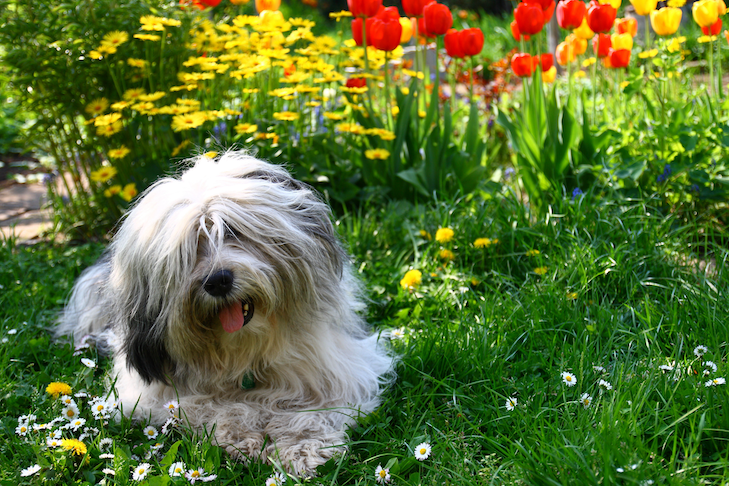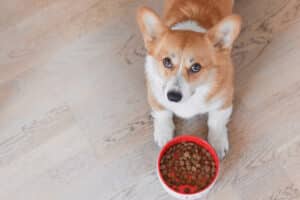It’s important to protect your pet from plants that are poisonous to dogs. Whether you’re an avid gardener or have a few potted plants on your front stoop, some plants might not be your dog’s friend. In fact, many shrubs, trees, and flowers commonly found in the garden and in the wild are dangerous if your dog eats them. Some can cause discomfort, some will make your dog miserable, and some can even be fatal if ingested.
Flowers and Bulbs Poisonous to Dogs
Autumn Crocus: These fall-blooming plants contain colchicine, which is extremely toxic, causing gastrointestinal bleeding, severe vomiting, kidney and liver damage, and respiratory failure. Symptoms might be delayed for several days, so don’t wait to seek veterinary attention if your dog has ingested any part of this plant.
Begonia: Often used in containers, these tubers can cause mouth irritation and difficulty swallowing when ingested.
Chrysanthemum: These common flowers contain lactones and pyrethrin, which cause intestinal irritation. While not lethal, eating any part of the plant can result in vomiting, diarrhea, excessive drooling, skin rashes, and loss of coordination.
Daffodil: Ingesting any part of the plant, especially the bulb, can cause severe vomiting, drooling, tremors, respiratory distress, convulsions, and heart problems.
Foxglove: All parts of these tall beautiful flowers, from the seeds to the petals, are extremely toxic to dogs. Ingestion can cause cardiac failure and even death.
Geranium: All varieties of this common container plant are poisonous to dogs. The symptoms include lethargy, low blood pressure, skin rashes, and loss of appetite.
Iris: Ingesting any part of the plant can cause skin irritation, drooling, diarrhea, vomiting, and lethargy.
Lily: With so many different varieties of lilies, it’s hard to remember which are dangerous and which are relatively benign. Some — for example, daylilies — are extremely toxic to cats, but cause only gastrointestinal upset in dogs. Others, such as the calla lily, release a substance that burns and irritates a dog’s mouth and stomach, and symptoms can be mild to severe.
Lily of the Valley: Symptoms of ingestion include diarrhea, vomiting, a drop in heart rate, and cardiac arrhythmia.
Tulip and Hyacinth: The bulb is the most toxic part, but any part of these early-blooming flowers can be harmful to dogs, causing irritation to the mouth and esophagus. Typical symptoms include excessive drooling and vomiting. If many bulbs are eaten, symptoms may include an increased heart rate and irregular breathing. With care from a vet, dogs usually recover with no further ill effects.
Shrubs That Are Poisonous to Dogs
Azalea and Rhododendron: Used in landscaping and found in the wild, the entire genus is extremely dangerous for dogs. Eating even a few leaves can cause serious issues, including vomiting, diarrhea, drooling, paralysis, shock, coma, and death.
Holly: Varieties include American holly, English holly, Japanese holly, and Christmas holly. Although some are less toxic than others, it is best to keep your dog away from any variety. Eating the leaves can result in vomiting, diarrhea, and gastrointestinal injury due to the plant’s spiny leaves. Symptoms include lip-smacking, drooling, and head shaking.
Hydrangea: With high concentrations of toxic substances in the flowers and leaves, ingestion, especially of the leaves and flowers, can cause lethargy, diarrhea, vomiting, and other gastrointestinal upsets.
Ivy: Although a vine rather than a shrub, ivy is a common part of many landscapes. The foliage of certain types of ivy plants is dangerous to dogs, although not usually lethal. Ingestion can result in excessive salivation and drooling, vomiting, diarrhea, a swollen mouth and tongue, and difficulty breathing.
Oleander: All parts of this popular ornamental shrub are toxic to humans and dogs. If your dog ingests the flowers or leaves, he can experience extreme vomiting, an abnormal heart rate, and even death. Other signs to look for include tremors, drooling, seizures, and weakness.
Peony: These gorgeous flowering plants contain the toxin paeonol in their bark and may cause vomiting and diarrhea if ingested in large amounts.
Sago Palm: Often used as an ornamental shrub in temperate zones, it’s considered one of the most toxic plants for dogs. Every part of the plant is toxic, especially the seeds. Ingesting just a few seedpods can result in acute liver failure. Symptoms include vomiting, diarrhea, and bloody stools, decreased appetite, and nosebleeds.
 Vojtaz/Shutterstock
Vojtaz/Shutterstock

Trees That Are Poisonous to Dogs
Black Walnut: The tree itself isn’t dangerous, but the nuts that fall to the ground can be. They start to decay very quickly and produce mold, so when a dog ingests them they cause digestive upset and even seizures.
Chinaberry: The berries, leaves, bark, and flowers of this tree all contain toxins that can result in anything from vomiting and diarrhea to weakness, slow heart rate, seizures, and shock.
Fruit trees: The fruits of trees such as plum, apricot, peach, and even avocado contain pits, and the seeds of cherries and apples contain toxins that can make your dog sick and are choking hazards. Even if they only eat the fruit, eating too much can cause diarrhea
Horse Chestnut (Buckeye): This tree contains saponin, which causes vomiting and diarrhea, dilated pupils, affects the central nervous system, and can also lead to convulsions and coma.
Japanese Yew: All varieties, from the dwarf to the giant trees, contain dangerous toxins that can be fatal to dogs. Symptoms include tremors, vomiting, difficulty breathing, and seizures. Because of their bright green leaves and red berries, they are popular holiday decorations – but they should not be used in homes where dogs live.
Other nut trees: As a general rule, nuts aren’t safe for dogs. Avoid letting your dog eat the nuts from almond, pecan, hickory, walnut, or other nut trees. Ingestion can cause gastrointestinal problems and intestinal blockage.

My Dog Ate a Toxic Plant — What Should I Do?
If you suspect your dog has eaten something toxic, follow these steps:
- Contact your vet, AKC Vetline, or the Pet Poison Helpline (855-764-7661) for accurate advice.
- Try to identify the plant by taking a sample, a photo, or by collecting the dog’s vomit in a plastic bag.
- When you reach the vet or helpline, provide as much information as possible, including:
- The suspected plant and the time of ingestion.
- Your dog’s weight.
- Any symptoms your dog is showing.
- Under no circumstances should you induce vomiting unless instructed to do so by the vet. Specific plant poisons require specific treatments, and vomiting can make some cases worse.
- Don’t fall for the myth that dogs instinctively avoid dangerous plants. While it is sometimes true of animals in the wild, dogs have no ability to distinguish between safe and unsafe plants.
According to American Kennel Club Chief Veterinary Officer Dr. Jerry Klein, the best cure is prevention. He recommends that you survey your yard regularly and identify any plants that may be dangerous. Then restrict your dog’s access to them. You may need to consult a landscaper to remove particularly stubborn plants. And when in doubt on whether a plant your dog ate may be poisonous, seek professional help. “The most common mistake pet owners make is to wait to see if the dog becomes ill before contacting the veterinarian,” says Dr. Klein.








